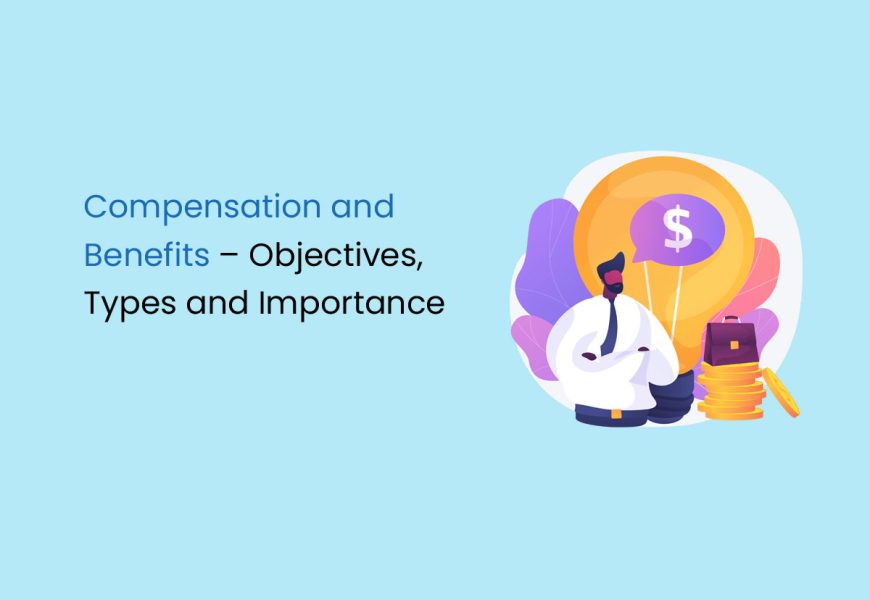Compensation and benefits are the rewards offered to employees for their services and contributions to an organisation. An appealing compensation and benefits plan can attract and retain top talent and keep them satisfied, motivated, and engaged.
This blog will discuss compensation and benefits–their types, advantages and importance.
What are Compensation and Benefits?
Compensation and benefits are monetary and non-monetary remuneration given to employees in exchange for their work and contributions to an organisation. Collectively, they make up a total compensation package. This package can include salary, bonuses, insurance, retirement contributions, and other perks.
A comprehensive and attractive compensation package is vital for job seekers when considering a new job. At the same time, the cost of compensation, benefits, and related taxes can make up a significant portion of a company’s expenses, up to 70%. Therefore, ensuring that the compensation and benefits offered are appropriate and competitive to attract and retain employees is essential.
While salary is a significant factor when considering a job offer, two job offers with the same salary may not be equal in terms of overall financial benefits. Each job offers different compensation packages, including bonuses, health insurance, vacation time, and other perks. Therefore, organisations must provide appropriate compensation packages to attract and retain suitable candidates.
Difference between Compensation and Benefits
Compensation refers to an employee’s financial remuneration in exchange for their services, such as salary, commissions, and bonuses. These payments are subject to taxation, and organisations use compensation to attract top talent and retain employees.
On the other hand, benefits refer to non-financial rewards or perks that an organisation provides to its employees. These include health insurance, stock options, gym memberships, flexible working hours, learning and development opportunities, and retirement savings plans. Some benefits are exempt from taxation.
So, the key difference between compensation and benefits is that compensation is financial remuneration, while benefits are non-financial.
Objectives of Compensation and Benefits
The objectives of compensation and benefits are as follows:
- Ensure Employees are Fairly Compensated: Employees should be compensated based on the market value of their job, their skills, experience, and training, as well as their performance.
- Attract The Right Employees: Companies must offer competitive salaries and benefits to attract top talent. Organisations should also promote the company’s culture and values.
- Create A Reward Structure: Establish a reward system that encourages employees to perform at their best. This can be achieved through various methods, such as incentive programs, commission structures, and stock options.
- Reduce Turnover and Promote Loyalty: Employees want more than a high salary. They want to feel valued as team members and to know their work is essential.
- Adhere To Legal Compliance: It is crucial to comply with all legal requirements, such as minimum wage, equal pay, and anti-discrimination laws.
Components of Compensation and Benefits
The components of compensation and benefits are as follows:
- Job Analysis: It is collecting and studying a job’s data and identifying its essential tasks, duties and responsibilities. The information collected is used to develop job descriptions, which are then used to determine the appropriate pay level for the position.
- Job Description: It outlines the duties, responsibilities, education, experience requirements, and any special skills or qualifications needed for the position, communicating the job expectations to candidates and facilitating the selection process.
- Compensation Strategy: A compensation strategy should outline a company’s plan to attract and retain top-tier talent and reward employees’ performance. This strategy will be based on the organisation’s goals, objectives, and budget.
- Pay Structures: Create a salary scale to outline the salary range for each position. The pay structure also includes any bonuses, commissions, or other available forms of compensation. Once designed, it needs the approval of the shareholders and board of directors.
- Implement the Plan: Communicate the plan to all employees. Monitor the implementation to ensure that the plan is working as intended and that there are no issues.
Types of Compensation and Benefits
The types of compensation and benefits are as follows:
Direct Compensation
Employers can use it to ensure that all employees are paid relatively within the organisation. This type of compensation covers all employee benefits, including salaries and health-related benefits. Additionally, compensating them adequately helps prevent the loss of well-trained employees to competing organisations.
Direct compensation includes:
- Basic Salary
- Sales Commission
- Overtime Pay
- Variable Pay (performance-based pay)
Indirect Compensation
Instead of cash benefits, indirect compensation offers employees multiple other benefits that help them feel valued and appreciated in the company. It helps create a sense of belonging and admiration among employees, increasing their loyalty to the organisation and reducing the likelihood of leaving.
Indirect compensation includes:
- Commissions
- Bonuses
- Stock options
Benefits
Full-time employees are typically given benefits to help with healthcare expenses, retirement, and vacation time. Companies offer these gifts based on employee wants and needs.
Benefits include;
- Gym membership
- Transportation reimbursement
- Childcare assistance
- Student loan repayment assistance
- Pet insurance reimbursement
- Employee discounts
- Health insurance
- Retirement plans
- Paid time off
- Employee assistance programs
- Internet reimbursement
- Travel reimbursement
- Relocation assistance
- Flexible working hours
- Paid time off
- Leave
- Retirement and pension plans
Total Compensation Package
A total compensation package combines direct and indirect compensation, which are presented to employees as part of their contract. This package is an essential part of a company’s talent acquisition strategy. Benefits are also included in the total compensation package.
Every new hire must receive a clear report of their compensation package and know whom to contact if they have any questions.
Importance of Compensation and Benefits
Compensation and benefits are significant because of the following:
- Attract and Retain Talent: In this highly competitive market, a competitive compensation and benefits package is crucial to attract and retain skilled talent to reduce turnover and associated costs.
- Motivate and Engage Employees: Compensation and benefits are vital motivators for employees. By receiving rewards and recognition, employees are likelier to perform at their best, increasing productivity and commitment to their work.
- Enhance Job Satisfaction: Employees who are fairly compensated and receive valuable benefits tend to experience higher job satisfaction, increasing loyalty and productivity.
- Promote Equity and Fairness: A fair compensation and benefits structure establishes clear guidelines for salaries, bonuses, and benefits to ensure fairness and equity within the organisation.
- Compliance with Legal Requirements: Organisations must comply with labour laws to protect employees and the company from legal liabilities, penalties, and reputational harm when designing compensation and benefits programs.
How to Improve Compensation and Benefits?
You can take the following steps to improve compensation and benefits:
- Conduct a Compensation and Benefits Analysis: Analyse compensation and benefits programs based on comprehensive standards, local rates, workforce needs and expectations.
- Benchmark Against Competitors: Research and gather information about competitors’ compensation and benefits to understand the current market standard and ensure offerings remain competitive.
- Seek Employee Feedback: Gain insights into employee perceptions and preferences about compensation and benefits by conducting surveys and one-on-one or group discussions.
- Review Compensation Structure: Assessing the compensation and benefits structure is vital to ensure fairness and transparency. This can be achieved by reviewing salaries and implementing a performance-based pay structure.
- Enhance Benefits Offering: Review the benefits package and identify areas for improvement. Offer a range of benefits like healthcare coverage, retirement plans, paid time off, and flexible work arrangements to address diverse employee needs.
- Communicate and Educate: Ensure employees understand and appreciate benefits and compensations by providing precise and transparent information.
- Monitor and Adjust: Review employee compensation and benefits regularly to monitor satisfaction and retention.
Metrics for Determining Compensation
Compensation metrics are crucial for managing compensation. Analysing current practices can address pay equity issues and help create a fair compensation structure to attract and retain employees. The metrics to pay attention to are as follows:
- Salary Range Penetration: Salary range penetration compares pay across the organisation and shows the position of a salary in its pay band. It looks at the salary compared to the entire pay range, not just the midpoint.
- Compa Ratio: The compa ratio compares an individual or group’s salary with the midpoint of a defined salary range. A low ratio could lead to losing employees, while a high ratio may negatively impact your bottom line.
- Range Spread: A range spread in employee compensation defines the pay range for a position, including minimum, mid-range, and maximum rates. These rates are established through market pay analysis and external benchmarking.
- Range Maximum: The range maximum is the highest rate an employer is willing to pay for a role, presented as a fixed amount or a range. Employees at this level are often high-potential or long-serving, possessing crucial skills. Paying them the maximum range is a recognition of their value and potential impact on the business.
Terms You Need to Know
Some Specialised terms used in compensation and benefits are:
- Total Rewards: The total rewards strategy encompasses all the benefits, incentives, perks, processes, and programs an employer provides to its employees.
- Gross Wage: Gross wages represent an employee’s taxable compensation before deductions like taxes are applied.
- Net Pay: Net pay is the income an employee receives after deductions for voluntary and mandatory benefits and taxes.
- Fixed Pay: Fixed pay is a set amount paid to an employee at the end of each payroll cycle, irrespective of hours worked or work completed.
- Differential Pay: Differential pay is the compensation given to employees for working beyond their agreed-upon hours or taking on extra responsibilities.
- Biweekly Pay: Biweekly pay is a compensation schedule in which employees receive payment every two weeks.
- Monthly Pay Period: A monthly pay period is when a company pays its employees once every month.
- Merit Increase: A merit increase refers to a salary raise granted to an employee in recognition of excellent performance or other notable achievements. It may occur annually or as a direct response to outstanding performance.
- Broadbanding: Broadbanding consolidates similar job classifications into a single pay band with a broader range of compensation levels, reducing the number of pay grades compared to a regular salary structure.
- Gainsharing: Gainsharing involves employees receiving a financial share of the company’s profits resulting from performance improvements they contributed to designing.
- Total Target Cash: Total Target Cash is the combined value of an employee’s cash-based compensation upon achieving expected results, encompassing their annual base salary and target performance-based bonus.
- Pay Mix: Pay mix is the ratio of fixed pay to variable pay in an employee compensation package.
Conclusion
Every company should implement compensation and benefits policies to facilitate future growth. The best talent in any organisation is always on the verge of being attracted by other companies with better packages and benefits. By providing them with adequate compensation and benefits, you can make sure that they stay loyal to the company, leading to better growth and faster progress for your organisation.
Frequently Asked Questions about Compensation and Benefits
How do employers determine compensation and benefits?
Employers set compensation and benefits based on company policies and laws while also considering the market rates for similar positions and the expectations of ideal candidates. All of this must be balanced against the available budget. Data analysis can be used to track the most popular benefits over time so that businesses can make necessary adjustments.
What role do bonuses play in compensation?
Bonuses are incentives given to employees for meeting specific goals or milestones, such as annual bonuses, performance bonuses, or profit-sharing.
Are stock options a standard part of compensation packages?
Stock options are often provided as a long-term incentive to encourage employees to contribute to the company's success. They allow employees to buy company stocks at a predetermined price.
How do companies address diverse employee needs in compensation packages?
Companies can foster inclusivity through flexible benefits, such as remote work options, wellness programs, and customisable benefits packages that accommodate different lifestyles and needs.
How often should companies review and update their compensation packages?
Companies should review their compensation packages regularly to ensure competitiveness and alignment with market standards. Adjustments should be made annually or as market conditions change.
Can employees negotiate their compensation packages?
Employees can negotiate their compensation, which includes salary, bonuses, and benefits. Effective negotiation involves research, clear communication, and an understanding the company's limitations.














